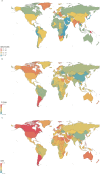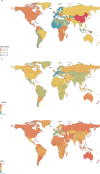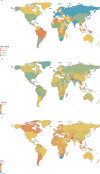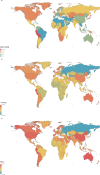Trends in prevalence and incidence of chronic respiratory diseases from 1990 to 2017
- PMID: 32046720
- PMCID: PMC7014719
- DOI: 10.1186/s12931-020-1291-8
Trends in prevalence and incidence of chronic respiratory diseases from 1990 to 2017
Abstract
Background: Chronic respiratory diseases (CRDs) are leading causes of morbidity worldwide. However, the spatial and temporal trends in prevalence and incidence of CRDs have not been estimated.
Methods: Based on data from the Global Burden of Diseases, Injuries, and Risk Factors Study 2017, we analyzed the prevalence and incidence trends of CRDs from 1990 to 2017 according to age, sex, region and disease pattern. Furthermore, the correlations between the incidence and the World Bank income levels, sociodemographic index (SDI), and human development index (HDI) levels were analyzed to assess the factors affecting incidence.
Result: The total number of CRD cases increased by 39.5% from 1990 to 2017, nevertheless, the age-standardized prevalence rate (ASPR) and age-standardized incidence rate (ASIR) showed decreasing trends. The ASIRs of CRD, chronic obstructive pulmonary disease (COPD), pneumoconiosis, and asthma decreased, whereas the ASIR of interstitial lung disease and pulmonary sarcoidosis increased during the past 27 years. Significant differences between males and females in the incidence rates of pneumoconiosis, interstitial lung disease and pulmonary sarcoidosis were observed. Elderly people especially suffered from CRDs, except for asthma. For COPD, the ASIR decreased from low-SDI regions to high-SDI regions. The ASIR of interstitial lung disease and pulmonary sarcoidosis in the high-SDI region was highest and have increased mostly. The ASIRs for pneumoconiosis and asthma were inversely related to the HDI.
Conclusions: In 2017, CRDs were still the leading causes of morbidity worldwide. A large proportion of the disease burden was attributed to asthma and COPD. The incidence rates of all four types of CRDs varied greatly across the world. Statistically significant correlation was found between the ASIR and SDI/HDI.
Keywords: Asthma; Chronic obstructive pulmonary disease; Chronic respiratory diseases; Global; Incidence.
Conflict of interest statement
The authors declare that they have no competing interests.
Figures








References
-
- Global surveillance, prevention and control of chronic respiratory diseases: a comprehensive approach. https://www.who.int/gard/publications/GARD_Manual/en/. Date last accessed: March 10, 2019.
-
- Yin P, Wang H, Vos T, Li Y, Liu S, Liu Y, Liu J, Wang L, Naghavi M, Murray CJ, Zhou M. A subnational analysis of mortality and prevalence of COPD in China from 1990 to 2013: findings from the global Burden of disease study 2013. Chest. 2016;150:1269–1280. doi: 10.1016/j.chest.2016.08.1474. - DOI - PubMed
MeSH terms
Grants and funding
LinkOut - more resources
Full Text Sources
Medical
Miscellaneous

